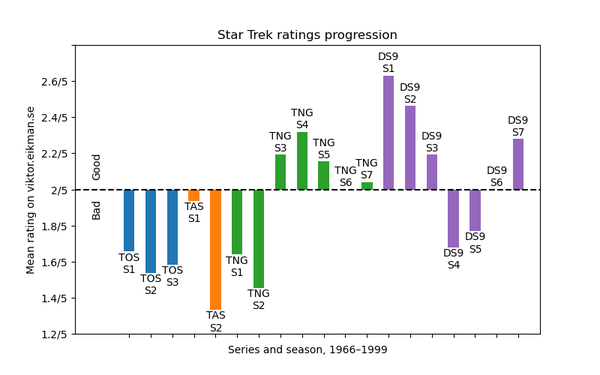Highlights of Star Trek TV
The best and most symptomatic of TOS–DS9
As a child I saw fragments of Star Trek (1966, TOS), The Next Generation (1987, TNG) and Voyager (1995, VOY) on broadcast television. From 2017, I watched all of TOS, The Animated Series (1973, TAS), TNG and Deep Space Nine (1993, DS9) in chronological order.
I did not hurry, because Trek is enshrined in the marketplace as the second most recognizable science fiction evergreen. It never seems to get hard to find. In popular culture, Trek has eclipsed all SF literature, being second only to Star Wars (1977). In 2022, 23 years after DS9 ended, Trek is still popular enough that more of it is always being sold to a dual audience of casual viewers and fans.
I am a fan of science fiction, not of Trek. When I stopped watching VOY in my teens, it was because I had given up hope on that series hitting the marks of good fiction, such as self-consistency, character development and depth of emotion. The weaknesses of the larger franchise extend beyond the constraints of worldbuilding for television production and quality control by omission. Around the early 1990s, though, Trek had a golden age where it was most often good.

My opinions averaged across each season.
Fortunately, because the old Trek shows were mostly episodic, you don’t have to watch the good with the bad the way I did. What follows are the highlights, whether in quality or otherwise. You can watch most of these without the full context.
| Show | Episode | Comment |
|---|---|---|
| TOS | “Arena” (1967) | The most entertaining episode of the original series. |
| “The Savage Curtain” (1969) | Boring but symptomatic of the franchise’s relationships with history, celebrity, security and moral philosophy, all tied up with television. | |
| TAS | “The Slaver Weapon” (1973) | A straight adaptation of an already published, unrelated story. This is unique in the franchise and shows what the episodic series could have been. |
| “The Jihad” (1974) | Trek at home as a goofy Saturday morning cartoon. | |
| TNG | “The Neutral Zone” (1988) | Unsentimental in laying out the social and technological utopia of the franchise. For more unsentimental goodness, see “Brothers” (1990). For the fear of the lotus that poisons the utopia and the franchise, see “The Game” (1991). |
| “The Inner Light” (1992) | The best of TNG, with “Darmok” (1991) and “Tin Man” (1990) coming in second and third, respectively. | |
| DS9 | “In the Hands of the Prophets” (1993) | The best of DS9. “It’s Only a Paper Moon” (1998), the runner-up, makes progress with the lotus. Both episodes are tied into the serialized narrative of DS9 and would be weak on their own. |
| “Our Man Bashir” (1995) | Boring in symptomatic ways that are fun to figure out. |
I finished DS9 the day after the death of actor Nichelle Nichols (1932–2022), who played communications officer Uhura on TOS. Nichols advanced the causes of feminism and anti-racism by playing a visibly competent professional while being a woman of colour. Racist viewers protested her presence and the studio agreed to feature her less, which meant featuring her too little. Uhura’s kiss on “Plato’s Stepchildren” (1968) made history in the US, but “The Lorelei Signal” (1973) is a better episode, where Uhura briefly takes command of the Enterprise. The latter episode is still notably sexist and racist, and the franchise’s record on gay rights is even worse, but Nichols was good.
I won’t keep watching Star Trek systematically. I know VOY is a pain. The movies are not better than the series. J. J. Abrams fast-talked himself into an alternate continuity, but that only worsened the problem of internal contradiction by omission. As far as I know, the franchise did not get watchable again until Star Trek: Lower Decks (2020), if it ever did.